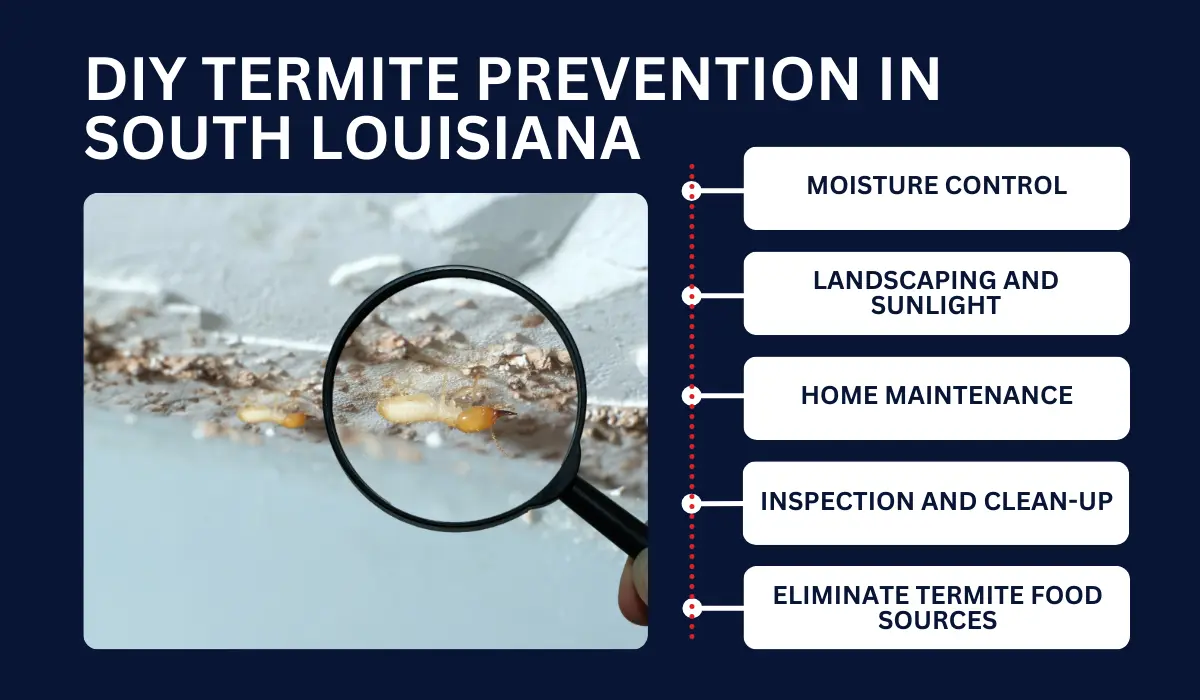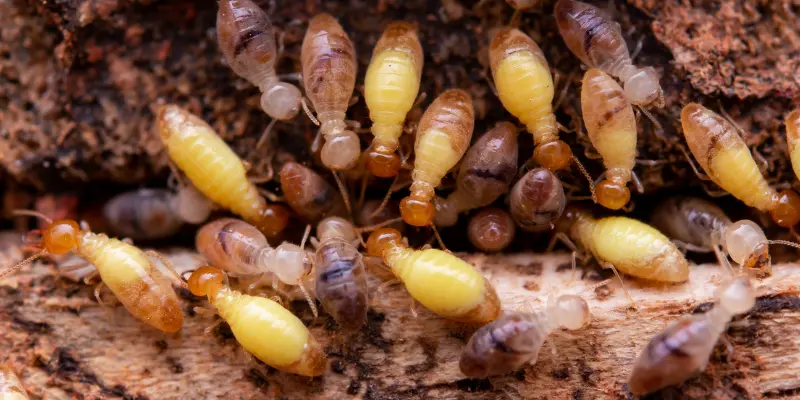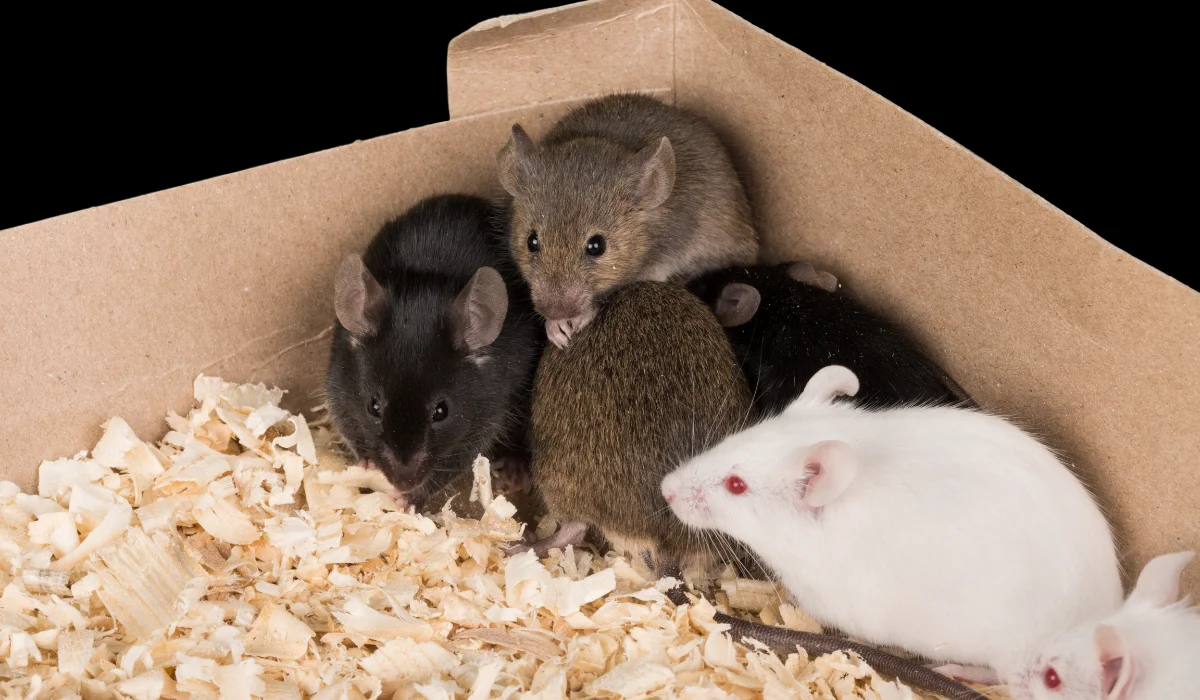Louisiana’s hot and humid weather is perfect for termites, which can put many homes at risk. Hence, knowing how to keep these pests away is crucial to protecting your property.
For instance, termites love moisture and wood, so managing water and minimizing wood-soil contact can help prevent an infestation. Regular home termite inspections and maintenance are also essential.
Keep reading to learn more about effective prevention methods to keep your home termite-free.
Key Takeaways
- To prevent termite infestation in Louisiana, establish barriers, such as a strip of crushed rocks between your foundation and mulch.
- Control moisture by fixing leaks and maintaining gutters, as humidity attracts termites.
- Limit dense planting near your home’s foundation to allow sunlight to dry the soil, making it less appealing to termites.
- Regularly inspect your home for signs of termites, such as mud tubes or frass, and remove potential food sources from around your property.
- For comprehensive prevention and treatment, consider professional termite exclusion services in Slidell that include regular inspections and customized pest management strategies
DIY TERMITE PREVENTION IN SOUTH LOUISIANA

Louisiana is home to different types of termites that may damage your property. To prevent the start of termite problems in the home, you can take proactive measures.
Moisture Control
As Louisiana homeowners, you should combat moisture since it’s a termite attractant. Necessary actions include:
| Recommended Actions | Description |
| Fix Leaky Faucets and Pipes | Address any leaks to prevent moisture accumulation that attracts termites. |
| Monitor Air Conditioning Units | Ensure that AC units do not cause water to pool near the foundation. |
| Maintain Clean Gutters | Regularly clean gutters to avoid water seepage into roofs and walls. |
Landscaping and Sunlight
As you plan your landscaping, consider how the placement of plants can affect the moisture levels around your home’s foundation.
- Plant strategically. Avoid dense planting near the house’s foundation so that sunlight can keep the soil dry, which is unappealing to termites.
Home Maintenance
Consider these key maintenance actions in your home maintenance:
| Recommended Actions | Description |
| Run Exhaust Fans Regularly | Operate exhaust fans in high-moisture areas like kitchens and bathrooms to reduce indoor humidity. |
| Repair Structural Damages | Fix any damages to the structure of your home to prevent potential entry points for termites. |
Inspection and Clean-up
Louisiana home’s crawl spaces should be inspected for vulnerabilities and fixed.
- Consider inspecting second-hand wooden items before they enter your home, as they might harbor drywood termites.
Eliminate Termite Food Sources
Take proactive steps to remove their potential food sources from around your property. Here’s how you can maintain a termite-free perimeter:
- Clear out potential termite food such as leaf piles, rotting wood, and old stumps to keep the perimeter of your home termite-free.
SIGNS OF TERMITE INFESTATION
While termite season may not be year-round, recognizing specific indicators of an infestation can safeguard a home from significant damage.
Early Signs of Termite Presence
As homeowners, you should look for the early signs of certain species of termites. Here’s a checklist you can consider:
- Frass: These granular droppings resemble sawdust and are often seen near wooden elements of the house.
- Mud Tubes: Subterranean termites construct protective tunnels out of mud on foundations and walls.
- Swarmers: Spotting winged termites inside or around the house, often indicating a nearby termite colony.
- Discarded Wings: Wings shed during termite swarms, typically found near window sills and baseboards.
- Clicking Sounds: Soft clicking noises from within walls or wooden structures suggest termite presence.
Assessing Termite Damage
Evaluating the amount of damage caused by termite infestation is crucial as well. Here are steps to follow after you detect termite damage in your property:
| Steps | Recommended Action |
| Inspect Wooden Structures | Inspect wood structures for hollow sounds or visible damage. |
| Check for Mud Tubes | Examine for mud tubes on walls and foundations, which indicate subterranean termite activity. |
| Monitor for Damage | Check for moisture damage as termites are drawn to damp wood. |
| Identify Structural Damage | Look for structural damage in the form of sagging floors or ceilings. |
| Consult a Professional | Engage a professional to assess the full extent of the damage. |
WHEN TO CALL THE EXPERTS?
As homeowners in Louisiana, you should be aware of these uninvited guests before significant damage is done.
So, immediately call termite control services to prevent drywood, subterranean, or Formosan termites if your DIY baiting system just doesn’t cut it.
Whether you’re in New Orleans or Baton Rouge, seeking expert help should be easy. For immediate intervention for a severe infestation, let Lajaunie’s termite control specialists tailor a solution that’s right for your home.
For more information about the areas we service, visit our location page.
 By: LaJaunie's Pest Control
By: LaJaunie's Pest Control 



